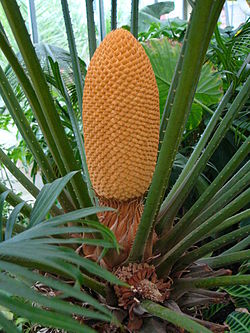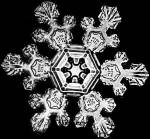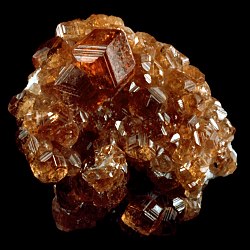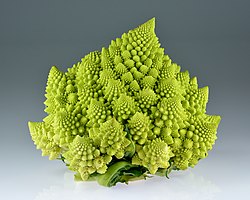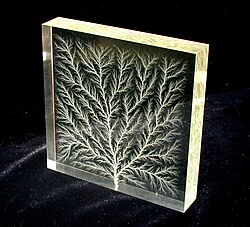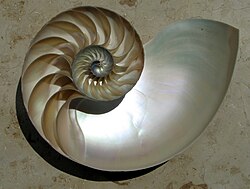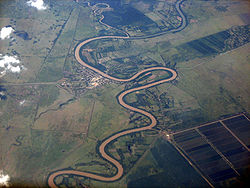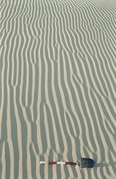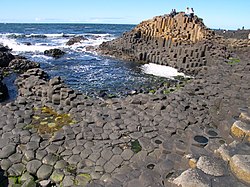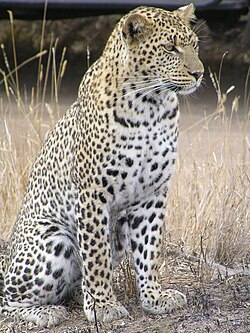Patterns in nature

Patterns in nature are visible regularities of form found in the
attempting to explain order in nature. The modern understanding of visible patterns developed gradually over time.In the 19th century, the Belgian physicist
History
Early Greek philosophers attempted to explain order in
In 1202,
In the 19th century, the Belgian physicist
In the 20th century,
-
Fibonacci number patterns occur widely in plants such as this queen sago, Cycas circinalis.
-
Beijing's National Aquatics Center for the 2008 Olympic games has a Weaire–Phelan structure.
-
D'Arcy Thompson pioneered the study of growth and form in his 1917 book.
Causes
Living things like orchids, hummingbirds, and the peacock's tail have abstract designs with a beauty of form, pattern and colour that artists struggle to match.[21] The beauty that people perceive in nature has causes at different levels, notably in the mathematics that governs what patterns can physically form, and among living things in the effects of natural selection, that govern how patterns evolve.[22]
Mathematics seeks to discover and explain abstract patterns or regularities of all kinds.[23][24] Visual patterns in nature find explanations in chaos theory, fractals, logarithmic spirals, topology and other mathematical patterns. For example, L-systems form convincing models of different patterns of tree growth.[19]
The laws of
In
Types of pattern
Symmetry
Among non-living things,
Symmetry has a variety of causes. Radial symmetry suits organisms like sea anemones whose adults do not move: food and threats may arrive from any direction. But animals that move in one direction necessarily have upper and lower sides, head and tail ends, and therefore a left and a right. The head becomes specialised with a mouth and sense organs (
-
Animals often show mirror orbilateral symmetry, like this tiger.
-
fivefold symmetry.
-
Fivefold symmetry can be seen in many flowers and some fruits like this medlar.
-
sixfold symmetry.
-
Fluorite showing cubic crystal habit.
-
Waterradial symmetry.
-
Garnet showing rhombic dodecahedral crystal habit.
-
Volvox has spherical symmetry.
-
Ice eggs gain spherical symmetry by being rolled about by wind and currents.
Trees, fractals
The branching pattern of trees was described in the Italian Renaissance by Leonardo da Vinci. In A Treatise on Painting he stated that:
All the branches of a tree at every stage of its height when put together are equal in thickness to the trunk [below them].[39]
A more general version states that when a parent branch splits into two or more child branches, the surface areas of the child branches add up to that of the parent branch.
Fractal-like patterns occur widely in nature, in phenomena as diverse as clouds,
-
The growth patterns of certain trees resemble these Lindenmayer system fractals.
-
Branching pattern of abaobabtree
-
Leaf of cow parsley,pinnate, not infinite
-
self-similarform
-
Trees: dendritic copper crystals (in microscope)
Spirals
Plant spirals can be seen in
In disc phyllotaxis as in the
From the point of view of physics, spirals are lowest-energy configurations
-
Fibonaccispiral
-
Bighorn sheep, Ovis canadensis
-
Spirals: phyllotaxis of spiral aloe, Aloe polyphylla
-
Nautilus shell's logarithmic growth spiral
-
sunflower, Helianthus annuus
-
Multiple Fibonacci spirals: red cabbage in cross section
-
Spiralling shell of Trochoidea liebetruti
-
Water droplets fly off a wet, spinning ball inequiangular spirals
Chaos, flow, meanders
In mathematics, a
Alongside fractals,
-
Chaos: shell of
-
Flow:Juan Fernandez Islands
-
Meanders: dramaticflood plain of the Rio Negro, seen from space
-
Meanders: sinuous path of Rio Cauto, Cuba
-
Meanders: sinuous snake crawling
-
Meanders: symmetrical brain coral, Diploria strigosa
Waves, dunes
-
Waves: breaking wave in a ship's wake
-
Dunes: sand dunes inTaklamakandesert, from space
-
Dunes: barchan crescent sand dune
Bubbles, foam
A soap bubble forms a sphere, a surface with minimal area (minimal surface) — the smallest possible surface area for the volume enclosed. Two bubbles together form a more complex shape: the outer surfaces of both bubbles are spherical; these surfaces are joined by a third spherical surface as the smaller bubble bulges slightly into the larger one.[11]
A foam is a mass of bubbles; foams of different materials occur in nature. Foams composed of soap films obey Plateau's laws, which require three soap films to meet at each edge at 120° and four soap edges to meet at each vertex at the tetrahedral angle of about 109.5°. Plateau's laws further require films to be smooth and continuous, and to have a constant average curvature at every point. For example, a film may remain nearly flat on average by being curved up in one direction (say, left to right) while being curved downwards in another direction (say, front to back).[73][74] Structures with minimal surfaces can be used as tents.
At the scale of living
-
Foam of soap bubbles: four edges meet at each vertex, at angles close to 109.5°, as in two C-H bonds in methane.
-
Radiolaria drawn by Haeckel in his Kunstformen der Natur (1904).
-
Haeckel's Spumellaria; the skeletons of these Radiolaria have foam-like forms.
-
Buckminsterfullerene C60: Richard Smalley and colleagues synthesised the fullerene molecule in 1985.
-
leafhoppers) often approximate fullerenegeometry.
-
Equal spheres (gas bubbles) in a surface foam
-
Circus tent approximates a minimal surface.
Tessellations
-
Crystals: cube-shaped crystals of halite (rock salt); cubic crystal system, isometric hexoctahedral crystal symmetry
-
Arrays: honeycomb is a natural tessellation
-
Tilings: tessellated flower of snake's head fritillary, Fritillaria meleagris
-
Tilings: overlapping scales of common roach,Rutilus rutilus
-
Tilings: overlapping scales of snakefruit or salak, Salacca zalacca
-
Tessellated pavement: a rare rock formation on the Tasman Peninsula
Cracks
Cracks are linear openings that form in materials to relieve stress. When an elastic material stretches or shrinks uniformly, it eventually reaches its breaking strength and then fails suddenly in all directions, creating cracks with 120 degree joints, so three cracks meet at a node. Conversely, when an inelastic material fails, straight cracks form to relieve the stress. Further stress in the same direction would then simply open the existing cracks; stress at right angles can create new cracks, at 90 degrees to the old ones. Thus the pattern of cracks indicates whether the material is elastic or not.[80] In a tough fibrous material like oak tree bark, cracks form to relieve stress as usual, but they do not grow long as their growth is interrupted by bundles of strong elastic fibres. Since each species of tree has its own structure at the levels of cell and of molecules, each has its own pattern of splitting in its bark.[81]
-
Old pottery surface, white glaze with mainly 90° cracks
-
Drying inelastic mud in the Rann of Kutch with mainly 90° cracks
-
VeinedSkye
-
Drying elastic mud in Sicily with mainly 120° cracks
-
Cooled basalt at Giant's Causeway. Vertical mainly 120° cracks giving hexagonal columns
-
Palm trunk with branching vertical cracks (and horizontal leaf scars)
Spots, stripes
Leopards and ladybirds are spotted; angelfish and zebras are striped.
-
Dirce beauty butterfly, Colobura dirce
-
Grevy's zebra, Equus grevyi
-
Royal angelfish, Pygoplites diacanthus
-
Leopard, Panthera pardus pardus
-
Array ofG.G. Jacobson
-
Breeding pattern of cuttlefish, Sepia officinalis
Pattern formation
Alan Turing,[17] and later the mathematical biologist James Murray,[83] described a mechanism that spontaneously creates spotted or striped patterns: a reaction–diffusion system.[84] The cells of a young organism have genes that can be switched on by a chemical signal, a morphogen, resulting in the growth of a certain type of structure, say a darkly pigmented patch of skin. If the morphogen is present everywhere, the result is an even pigmentation, as in a black leopard. But if it is unevenly distributed, spots or stripes can result. Turing suggested that there could be feedback control of the production of the morphogen itself. This could cause continuous fluctuations in the amount of morphogen as it diffused around the body. A second mechanism is needed to create standing wave patterns (to result in spots or stripes): an inhibitor chemical that switches off production of the morphogen, and that itself diffuses through the body more quickly than the morphogen, resulting in an activator-inhibitor scheme. The Belousov–Zhabotinsky reaction is a non-biological example of this kind of scheme, a chemical oscillator.[84]
Later research has managed to create convincing models of patterns as diverse as zebra stripes, giraffe blotches, jaguar spots (medium-dark patches surrounded by dark broken rings) and ladybird shell patterns (different geometrical layouts of spots and stripes, see illustrations).
Patterns can form for other reasons in the
In permafrost soils with an active upper layer subject to annual freeze and thaw,
The
-
Giant pufferfish, Tetraodon mbu
-
Detail of giant pufferfish skin pattern
-
Snapshot of simulation of Belousov–Zhabotinsky reaction
-
Helmeted guineafowl,Numida meleagris, feathers transition from barred to spotted, both in-feather and across the bird
-
White Mountains, New Hampshire
-
Fairy circles in the Marienflusstal area in Namibia
See also
- Developmental biology
- Emergence
- Evolutionary history of plants
- Mathematics and art
- Morphogenesis
- Pattern formation
- Widmanstätten pattern
References
Footnotes
- ^ The so-called Pythagoreans, who were the first to take up mathematics, not only advanced this subject, but saturated with it, they fancied that the principles of mathematics were the principles of all things. Aristotle, Metaphysics 1–5 , c. 350 BC
- ^ Aristotle reports Empedocles arguing that, "[w]herever, then, everything turned out as it would have if it were happening for a purpose, there the creatures survived, being accidentally compounded in a suitable way; but where this did not happen, the creatures perished." The Physics, B8, 198b29 in Kirk, et al., 304).
Citations
- ^ Stevens 1974, p. 3.
- ^ Balaguer, Mark (7 April 2009) [2004]. "Platonism in Metaphysics". Stanford Encyclopedia of Philosophy. Retrieved 4 May 2012.
- ^ ISBN 978-0-7679-0816-0.
- ^ Da Vinci, Leonardo (1971). Taylor, Pamela (ed.). The Notebooks of Leonardo da Vinci. New American Library. p. 121.
- ISSN 0047-6269.
- ^ Knott, Ron. "Fibonacci's Rabbits". University of Surrey Faculty of Engineering and Physical Sciences.
- Browne, Thomas (1658). "Chapter III". The Garden of Cyrus.
- ISBN 978-0-419-22780-9.
- .
- ^ Zeising, Adolf (1854). Neue Lehre van den Proportionen des meschlischen Körpers. preface.
- ^ a b Stewart 2001, pp. 108–109.
- ^ Ball 2009a, pp. 73–76.
- ^ Ball 2009a, p. 41.
- ISBN 978-0-415-97235-2.
- ^ ISBN 978-0-7679-0816-0.
- ^ About D'Arcy Archived 2017-07-01 at the Wayback Machine. D' Arcy 150. University of Dundee and the University of St Andrews. Retrieved 16 October 2012.
- ^ S2CID 937133.
- ^ Ball 2009a, pp. 163, 247–250.
- ^ ISBN 0-12-597140-0
- ^ a b Mandelbrot, Benoît B. (1983). The fractal geometry of nature. Macmillan.
- ^ Forbes, Peter. All that useless beauty. The Guardian. Review: Non-fiction. 11 February 2012.
- ^ Stevens 1974, p. 222.
- S2CID 4849363. Archived from the originalon 2010-10-28. Retrieved 2012-05-02.
- ^ Devlin, Keith. Mathematics: The Science of Patterns: The Search for Order in Life, Mind and the Universe (Scientific American Paperback Library) 1996
- ^ Tatarkiewicz, Władysław. "Perfection in the Sciences. II. Perfection in Physics and Chemistry". Dialectics and Humanism. 7 (2 (spring 1980)): 139.
- ^ a b c Darwin, Charles. On the Origin of Species. 1859, chapter 4.
- ^ a b Wickler, Wolfgang (1968). Mimicry in plants and animals. New York: McGraw-Hill.
- JSTOR 1312929.
- ^ Koning, Ross (1994). "Plant Physiology Information Website". Pollination Adaptations. Retrieved 2 May 2012.
- ^ Stewart 2001, pp. 48–49.
- ^ Stewart 2001, pp. 64–65.
- ^ Stewart 2001, p. 52.
- ^ Stewart 2001, pp. 82–84.
- ^ Stewart 2001, p. 60.
- ^ Stewart 2001, p. 71.
- ^ Hickman, Cleveland P.; Roberts, Larry S.; Larson, Allan (2002). "Animal Diversity" (PDF). Chapter 8: Acoelomate Bilateral Animals (Third ed.). p. 139. Archived from the original (PDF) on 17 May 2016. Retrieved 25 October 2012.
- S2CID 84195721.
- ^ "Image of the Week – Goodness gracious, great balls of ice!". Cryospheric Sciences. Retrieved 2022-04-23.
- ISBN 978-0-486-22572-2.)
{{cite book}}: CS1 maint: location missing publisher (link - ^ a b Palca, Joe (December 26, 2011). "The Wisdom of Trees (Leonardo Da Vinci Knew It)". Morning Edition. NPR. Retrieved 16 July 2019.
- .
- ^ Falconer, Kenneth (2003). Fractal Geometry: Mathematical Foundations and Applications. John Wiley.
- ^ Briggs, John (1992). Fractals:The Patterns of Chaos. Thames and Hudson. p. 148.
- ^ Batty, Michael (4 April 1985). "Fractals – Geometry Between Dimensions". New Scientist. 105 (1450): 31.
- ISBN 9782863321300.
- ISBN 978-9810237929.
- ^ Hahn, Horst K.; Georg, Manfred; Peitgen, Heinz-Otto (2005). "Fractal aspects of three-dimensional vascular constructive optimization". In Losa, Gabriele A.; Nonnenmacher, Theo F. (eds.). Fractals in biology and medicine. Springer. pp. 55–66.
- S2CID 4158401.
- PMID 28690919.
- ^ Addison, Paul S. (1997). Fractals and chaos: an illustrated course. CRC Press. pp. 44–46.
- ^ Maor, Eli. e: The Story of a Number. Princeton University Press, 2009. Page 135.
- ^ Ball 2009a, pp. 29–32.
- ^ "Spiral Lattices & Parastichy". Smith College. Archived from the original on 26 May 2010. Retrieved 24 September 2013.
- ^ a b Kappraff, Jay (2004). "Growth in Plants: A Study in Number" (PDF). Forma. 19: 335–354. Archived from the original (PDF) on 2016-03-04. Retrieved 2012-05-02.
- ^ Ball 2009a, p. 13.
- ^ Coxeter, H. S. M. (1961). Introduction to geometry. Wiley. p. 169.
- .
- ISBN 978-0-387-97297-8.
- S2CID 250864634.
- PMID 10045303.
- ^ Ball 2009a, pp. 163, 249–250.
- .
- ^ Elaydi, Saber N. (1999). Discrete Chaos. Chapman & Hall/CRC. p. 117.
- Bibcode:1991chch.book.....R.
- ^ Wolfram, Stephen (2002). A New Kind of Science. Wolfram Media.
- ISBN 978-0486434858.
- ^ Lewalle, Jacques (2006). "Flow Separation and Secondary Flow: Section 9.1" (PDF). Lecture Notes in Incompressible Fluid Dynamics: Phenomenology, Concepts and Analytical Tools. Syracuse, New York: Syracuse University. Archived from the original (PDF) on 29 September 2011..
- ^ French, A. P. (1971). Vibrations and Waves. Nelson Thornes.
- ^ Tolman, H. L. (2008). "Practical wind wave modeling" (PDF). In Mahmood, M.F. (ed.). CBMS Conference Proceedings on Water Waves: Theory and Experiment. Howard University, USA, 13–18 May 2008. World Scientific Publications.
- ^ "Types of Dunes". USGS. 29 October 1997. Retrieved May 2, 2012.
- ^ Strahler, A.; Archibold, O. W. (2008). Physical Geography: Science and Systems of the Human Environment (4th ed.). John Wiley. p. 442.
- S2CID 688445.
- ^ Ball 2009a, p. 68.
- .
- ^ Ball 2009a, pp. 96–101.
- ^ Brodie, Christina (February 2005). "Geometry and Pattern in Nature 3: The holes in radiolarian and diatom tests". Microscopy-UK. Retrieved 28 May 2012.
- ^ Ball 2009a, pp. 51–54.
- ^ Armstrong, M.A. (1988). Groups and Symmetry. New York: Springer-Verlag.
- ISBN 978-0-471-92804-1
- ^ Stevens 1974, p. 207.
- ^ Stevens 1974, p. 208.
- ^ a b Ball 2009a, pp. 156–158.
- ISBN 978-3-662-08539-4.
- ^ a b Ball 2009a, pp. 159–167.
- ^ Ball 2009a, pp. 168–180.
- ^ Rothenberg 2011, pp. 93–95.
- ^ PMID 11958709.
- ^ a b Tongway, D. J.; Valentin, C.; Seghieri, J. (2001). Banded vegetation patterning in arid and semiarid environments. New York: Springer-Verlag.
- ^ a b D'Avanzo, C. (22 February 2004). "Fir Waves: Regeneration in New England Conifer Forests". TIEE. Retrieved 26 May 2012.
- ^ Morelle, Rebecca (2013-12-09). "'Digital gophers' solve Mima mound mystery". BBC News. Retrieved 9 December 2013.
- ^ Sample, Ian (18 January 2017). "The secret of Namibia's 'fairy circles' may be explained at last". The Guardian. Retrieved 18 January 2017.
- ^ "Permafrost: Patterned Ground". US Army Corps of Engineers. Archived from the original on 7 March 2015. Retrieved 17 February 2015.
- ^ Ghose, Tia. "Human Brain's Bizarre Folding Pattern Re-Created in a Vat". Scientific American. Retrieved 5 April 2018.
- PMID 25136099.
Bibliography
Pioneering authors
- Fibonacci, Leonardo. Liber Abaci, 1202.
- ———— translated by Sigler, Laurence E. Fibonacci's Liber Abaci. Springer, 2002.
- Haeckel, Ernst. Kunstformen der Natur (Art Forms in Nature), 1899–1904.
- Thompson, D'Arcy Wentworth. On Growth and Form. Cambridge, 1917.
General books
- Adam, John A. Mathematics in Nature: Modeling Patterns in the Natural World. Princeton University Press, 2006.
- Ball, Philip (2009a). Nature's Patterns: a tapestry in three parts. 1: Shapes. Oxford University Press.
- Ball, Philip (2009b). Nature's Patterns: a tapestry in three parts. 2: Flow. Oxford University Press.
- Ball, Philip (2009c). Nature's Patterns: a tapestry in three parts. 3. Branches. Oxford University Press.
- Ball, Philip. Patterns in Nature. Chicago, 2016.
- Murphy, Pat and Neill, William. By Nature's Design. Chronicle Books, 1993.
- Bloomsbury Press.
- Stevens, Peter S. (1974). Patterns in Nature. Little, Brown & Co.
- Stewart, Ian (2001). What Shape is a Snowflake? Magical Numbers in Nature. Weidenfeld & Nicolson.
Patterns from nature (as art)
- Edmaier, Bernard. Patterns of the Earth. Phaidon Press, 2007.
- Macnab, Maggie. Design by Nature: Using Universal Forms and Principles in Design. New Riders, 2012.
- Nakamura, Shigeki. Pattern Sourcebook: 250 Patterns Inspired by Nature.. Books 1 and 2. Rockport, 2009.
- O'Neill, Polly. Surfaces and Textures: A Visual Sourcebook. Black, 2008.
- Viking Penguin, 1990.
